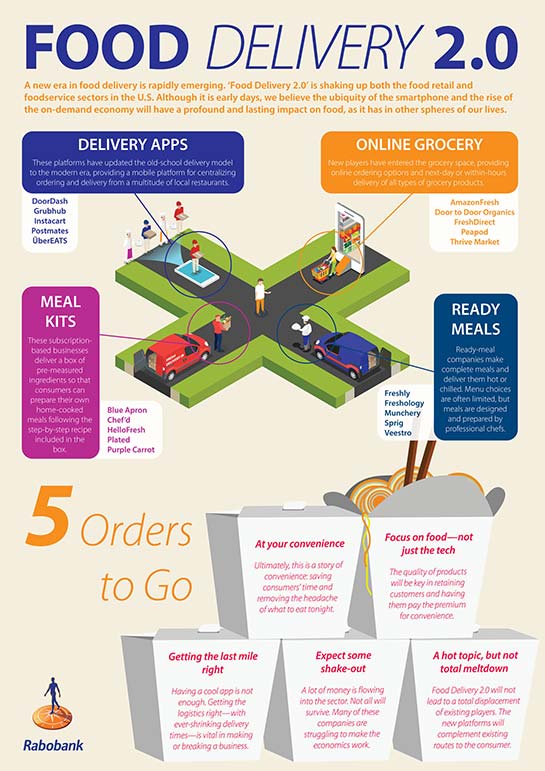A new era in food delivery is rapidly emerging, shaking up both the food retail and foodservice sectors in the United States and elsewhere. For many, the idea of browsing the supermarket aisles is increasingly irrelevant when compared to the convenience of ordering food with a few clicks on a cell phone. While the trend is still in its early days, Rabobank analysts Nicholas Fereday and Paula Savanti believe the ubiquity of the smart phone and the rise of the on-demand economy will have a profound and lasting impact on food, as it has in other spheres of everyday life.
“We dub this Food Delivery 2.0,” said Fereday. “As technology lowers the barriers to entry, it threatens to disrupt both food retail and traditional take-out food service. These new services satisfy our increasing desire for convenience, mass personalization, and our preference for managing more of our lives online.” In their latest report, Fereday and Savanti identify five key elements driving the surge in food delivery popularity:
- At your convenience. Ultimately, this is a story of convenience. Saving consumers’ time and making their lives a little easier – removing the headache of what to eat tonight.
- Focus on food, not just the tech. The future is about food and logistics. The pricing and quality of products will be key in determining the winners in the ready meal and grocery space.
- Getting the last mile right. Having a cool app, or other technology, is not enough, as it does not diminish the age-old dilemma of getting the product from A to B as quickly as possible. Getting the logistics right – with ever-shrinking delivery times – is vital in making or breaking a business.
- Expect some shakeout. A lot of money is flowing into the sector. But who will survive? Despite stratospheric valuations, many of these companies are struggling to make the economics work.
- A hot topic, but not total meltdown. Food Delivery 2.0 will not lead to a total displacement of existing players, but we do see a long-term future for these new platforms to complement the existing routes to the consumer.
“Competition for the consumer’s food dollar has never been greater,” said Savanti. “Last year, the amount we spent at restaurants and other food service venues exceeded our grocery shopping bills for the first time – a major milestone.”

About Rabobank
Rabobank Group is a global financial services leader providing wholesale and retail banking, leasing, real estate services, and renewable energy project financing. Founded over a century ago in the Netherlands, Rabobank is one of the largest banks in the world, with approximately $750 billion in assets and operations in more than 40 countries. In North America, Rabobank is a premier bank to the food, beverage and agribusiness industry. Its Food & Agribusiness Research and Advisory team is comprised of more than 80 analysts around the world who provide expert analysis, insight and counsel to Rabobank clients about trends, issues and developments in all sectors of agriculture.





